IN ENGLISH
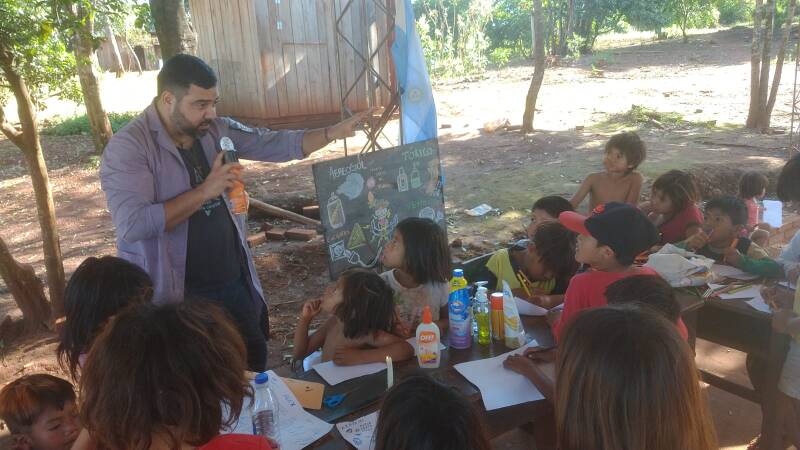
ROADING SCHOOL CHALK ROADS 🚸👣
📱💻www.facebook.com/caminosdetiza/
Initial Literacy 📝
School Support 👨🏾🏫
Comprehensive Sexual Education 🚻 (ESI)
Primary Health Care (from the Educational)⛑️
Pedagogical Therapeutic Approaches ♿
Artisanal Didactics (Inclusive Teaching Designs)
Tekom'boe Library 📚
Early-Timely Stimulation / Sensory Integration / Psychomotricity 👩
Psychoprophylaxis 💉
Scientific Literacy 🔬
PALLIATIVE EDUCATION - EMERGENCY PEDAGOGY
Complementary:
Solidarity Wardrobe 👖👕
Activism in RIGHTS (Human, Child, Disability Convention) 📃
Recreational and Sports Activities ⚽
Emergency Pedagogy🔥🌨️🌪️⚡🐍🦂🕷️ 🐝🔌 🚫
It is a conception of teaching-educational processes, systems and products, which seek to attend and address the situational problems of a group or collective (indigenous village, neighborhood, rural colony, etc.); It means that the selected educational dynamics (classes, workshops, projects, etc.) are seen/focused on eventual and emerging needs that occur in the context (floods, refugees, pandemics, etc.).
Despite the paradigms of diversity, inclusion, and a potpourri of pedagogical currents, in the formal educational system (se) the schooling of intelligence, 'normalization', and the much feared 'banking pedagogy' focused more on content teaching, than in the learning of skills (cognitive and cognitive).
The significance of learning lies in the immediate social utility of what has been learned, and how much this impacts on improving the quality of life of collectives/groups or subjects.
Far then from meritocracy and papyrocracy (certification phenomenon), Community Education (Non-Formal), focuses on subjects excluded from the system or with discontinuous traces of schooling.
In this context, in dynamics that do not contemplate age structures or grades, the objective of the educational intervention lies in working on learning strategies, study techniques, and social and intellectual competences from and from 'curricular' contents adapted to the needs specific to the context (dumps, indigenous villages, rural colonies, gypsies, diasporas, evacuees, refugees, etc.)
This is nothing more than, educationally addressing the need for functional and executive tools of 'that' community (and at that time).
This implies, for example, working on Primary Health Care (PHC), Comprehensive Sexual Education (Sexually Transmitted Diseases), purifying water, disease prevention, etc. from the teaching of the Cs. natural.

Respect for the Language, the dialects, and sometimes even the beliefs of the Culture, while Rights (Human and Children) or Laws are taught (to provide regulatory tools in cases of Abuse, Violence, Gender, etc. ), example of topics addressed from the Cs. Social.
The didactic instantiations seek to address structural and conjunctural problems, with pedagogical times in accordance with social rather than administrative dynamics (school calendar). Situations such as harvests, harvests, floods, cultural festivities must then be addressed, and work sequences designed that are not affected by them.
In these contexts, despite combating and reporting child labor (another example), the process is gradual and one must be aware that, for some families, the educational space is not valued, and affects the workforce provided by a child in the family economy, which may imply the abandonment of the educational space by the minor.
This type of educational work must ensure the principle of secularism (no political-partisan or religious affiliation) and be understood as a process of joint construction with community actors, from which Public Policies for attention and containment can be generated and projected, ( re)institutionalizing the subjects in public-state systems, to avoid depending on the wills or possibilities of individuals or private groups.
Only the State can guarantee (and must ensure) permanent attention, since it is forced to do so, with the allocation of permanent human and material resources.
Community action must be the way to, and not the end of.
In summary, Emergency Pedagogy must design, develop and implement didactic-pedagogical strategies, from a 'curricular' that contemplates the conjunctural and manifest problems of the group.
It forces one to get rid of labels, stigmas and ethnocentric and/or Eurocentric prejudices, to contemplate bilingualism and interculturalism.
It forces the design of safety and hygiene protocols (work with contagious infectious diseases: dengue, leprosy, scabies, HIV, and immunosuppressed children, in contexts with pathogenic vectors: garbage, insects, etc.).
Class on Thermal Alerts (Cold) and Water Alert (care/conservation of drinking water)
Alerts issued by the provincial authorities.
PSYCHOPROPHYLAXIS
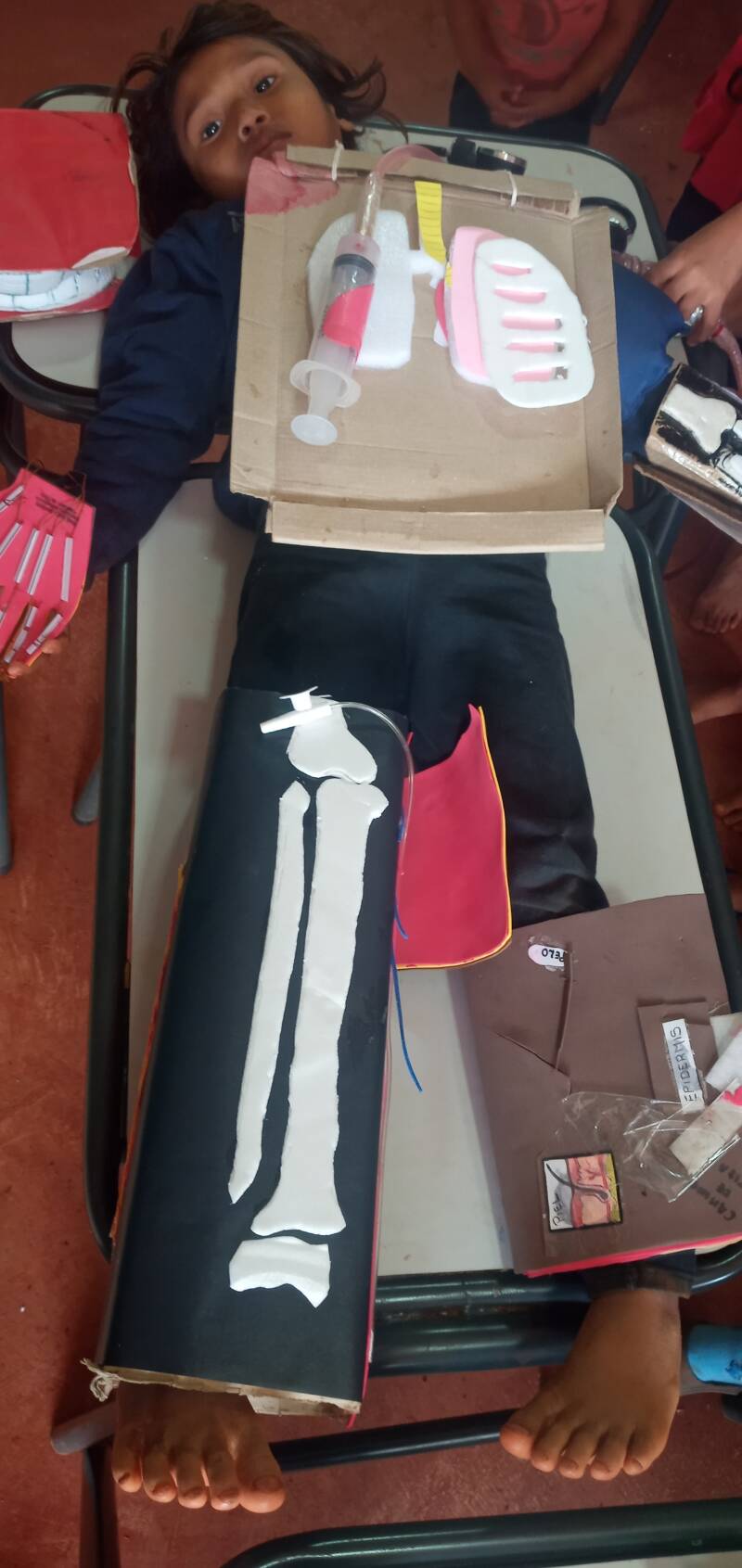
Julio Pereyra
Mobile School Caminos de Tiza (Argentina)
www.facebook.com/caminosdetiza/
The proposal lies in descriptive-exemplary experiential anticipators of types and uses of clinical-medical elements that reduce the stressors that these materials and/or interventions from fear and/or sensory saturation can generate.
It is a therapeutic-pedagogical action oriented/focused on Disability (especially cases of ASD/Autism, TEL, and the Deaf), which suppresses/minimizes emerging behaviors that may be due to textures, sounds, temperatures, pressures (etc.) and /or ignorance of the implications of such resources/devices/elements.
With dynamic, static, 3D and interactive craft elements, added to specific medical material (stethoscope, blood pressure monitor, thermometer, oximeters, needles, syringes, etc.), stage and simulate clinical care procedures as an alternation/complement of Cognitive Accessibility resources ( PECS, ARASAAC, Pictograms, Interpreter of/in Sign Language, Translator, etc.), exemplifying/describing/explaining sequences of use, intentions, etc., officiating as anticipators/organizers.
(Pre)Supposes anticipating already systemic actions in/for controls, such as in/in emergencies.
Understands/attends to issues such as sutures, concealment, blood pressure/tension measurement, thermometer placement (its sounds), even (simulation) wound cleaning (for example).
This educational format can be re/applied in/for other hygiene/sanitary experiences such as brushing teeth, cutting hair/hair and/or nails, etc.
These (pedagogical) processes that follow a propaedeutic logic, consider Functional and/or Linguistic Diversity, propose a palliative neuropsychotraining in/before sensory disorders, asking to be used both in/for the Health and Education areas.
With the principle of experiential predictability, manipulations, experiments and previous explorations, reproduce/imitate action sequences (from the ludic-didactic and interactive game), association and recognition are worked on/addressed in safe environments (individual and collective).
This psycho-didactic task combines the bio-medical model (recognizing the bio-physical dimensions of Disability and/or Illness/Diagnosis) and the Social one from: Cognitive Accessibility, Informed Consent, Subject of Law, etc.
This is not only attending, but also understanding the adjustments/adaptations that are necessary to guarantee Rights and Health care/assistance, as derivatives of this, such as privacy, autonomy, confidentiality, etc.
Escuelita Ambulante Caminos de Tiza (Argentina) develops an Itinerant Education system based on Installed Capacity, which promotes the teaching of preventive actions and interventions in the context of problems that affect collective and/or individual health. From information, instruction, teaching of techniques, ways and means of prevention of Zoonoses and/or Parasitosis (Dengue, Leishmania, Pediculosis, Scabies, Tungiasis, etc.), to prevention of Accidents with poisonous/poisonous Animals, domestic accidents (electrocutions, poisonings , burns), through teaching the uses of orthoses and prostheses, clinical materials and drugs, in remote communities, with low/no connectivity, in rural areas, Intercultural -Bilingual, or vulnerable-precarious conditions.
It is an Educational Pedagogical model (Emergency Pedagogy / Palliative Education), which innovates in a Primary Health Care model, which teaches topics such as teaching the uses of nebulizers, anti-decubitus mattresses and postural hygiene, for example, to uses, maintenance and repair of materials such as wheelchairs, standing frames, reciprocators or orthopedic beds.
It is an itinerant intervention model, which goes to the communities (villages, villages, towns, in rural areas and the jungle), educating/teaching hygiene techniques (tooth brushing, uses of the fine comb, nail cutting, uses of feminine hygiene materials, etc.), to Comprehensive Sexual Education in the prevention of Sexually Transmitted Infections, Adolescent pregnancy, contraceptive methods, etc., which has as an innovation the possibility of being replicated in/for transhumant communities, in contexts of displaced and/or refugees, as well as in post-disaster zones (earthquakes, tsunamis, floods, etc.).
It provides a low/zero cost model, replicable (scalable), with traceable impact (documented, registered, with evidence), whose format responds to communities in modes of action in situations of Health Alerts (Pandemics, Epidemics) Alerts State (high/low temperatures, floods, fires, etc.), or everyday issues such as water purification, food conservation, responsible pet ownership, or the recognition of insects/arachnids and snakes.
In Disability, a Psicoprophylaxis model is added from ideo-visual designs, interactive touch, biosimulation (handicrafts and ICTs), which act as anticipators, to avoid stressors in children with Disabilities by understanding/attending (interacting and dramatizing) with instruments ( stethoscopes, blood pressure monitors, oximeters, syringes, catheters, etc.) and procedures (extraction, vaccination, suturing, putting a cast on fractures, etc.), combined with Augmentative Alternative Communication (Pictograms) avoiding disruptive behaviors and violent/fearful reactions to clinical - medical procedures.
These playful - didactic - recreational approaches allow, from scientific literacy and phenomenological awareness (from observing, experimenting, manipulating and practicing) learning about uses of elements (combs, toothbrushes, face masks, nail clippers, feminine hygiene products such as sanitary towels, etc.), to functional autonomy (example catheters)
These supports, which can (also) be understood as part of a Therapeutic Accompaniment process, frame Accessibility and Usability in a teaching strategy that aims to break down/minimize cognitive-cognitive and physical-sensory obstacles, referring to the understanding of actions/procedures. , especially those that (invasive) in their perceptual-sensory incidence can be placed within: Sensory Saturation (for example, the pressure on the arm of a tensiometer), linked to Pain Thresholds (Vaccine, Injectable, etc.), Accessible Language (for not 'frighten'), etc.
The development of alternative/complementary strategies and/or resources, whether ideo-visual, or tactile-perceptive, dynamic and/or static, require this type of innovation (ideal for Therapeutic Centers, Home and Hospital Modality, Pediatrics, etc.) allow for personalized support (Person Centered Planning).
Psychoprophylaxis can then be defined as: a series/"set of strategies/teachings that, as anticipators, provide advice, accompaniment and/or education, as specialized help/support capable of in turn teaching processes of (self)intervention (example: placement gauze, probes, catheters, bandages, etc.).
Education (in the case of adolescents and/or adults) provides a way of exercising autonomy, providing PwD with a functional reference to prevent abuse/malpractice by caregivers, and possibly (depending on situations and diagnoses) less dependency of assistance.
Thus, it prevents forms of violence (real and symbolic, conscious or unconscious), in this case physical-linguistic and attitudinal,⁰ as well as psychological damage (traumas and phobias).
As an Intervention Model, it foresees an educational/training dimension that in parallel provides specialized/specific aid that undoubtedly contemplates factors of the GENCAT Scale.
From being a proposal that respects the Mental Health Law (Argentina), to considering access to psychological aid, Psychoprophylaxis culminates by referring to understanding, autonomy and self-determination, going through 3 (three) key elements of medical care: informed consent , security (emotional) and intimacy.
Covering in its (pedagogical) conception the promotion of assistance and prevention, as a mechanism of form/mode/means of therapeutic response that in itself (itself) encompasses: organization, structuring, predictability, and is/are configured as facilitator/s.
Its conception from concrete material/s (factual/concrete thought), even highly functional in Visual Impairment (Blindness and Low Vision), allows access to information that can not only avoid emergent reactions of resistance and crisis, but also (it is ), including teaching routine performances.
The material that exceeds in accessibility the (mere) simple instruction and/or drawing, can even become an element of communication aid in intercultural-bilingual contexts (Native/Indigenous Peoples) or in circumstantial cases such as assistance to a foreigner (who manages another language).
These therapeutic-didactic inputs, fundamental as an interpreter in/of Sign Language and/or Translator (of native or foreign language), seek functionality (methodological-operative) in the face of Functional Diversity/Neurodivergences within the precepts of Primary Care of Health (APS).
Drawings, PECS, signage, bimodalism, everything is combined to guarantee access to Health (Human Right, Child Rights Convention Pc/Disability).
This type of didactic instantiation considers proprioceptive factors and sensory integration, plausible instances of being carried out with low/null cost elements (handcrafted/recycled) which in turn (con)form a resource bank for (the) teaching of anatomy, physiology, biology, etc.; It provides a practical-procedural dimension (methodological, extending the ARASAAC System from the plane to space (which represents a plus in the aforementioned Cognitive Accessibility).
With materials that are easy to transport (low/zero weight), repairable at almost zero cost, easily (re)producible, and with hygienic designs that in turn respect the principles of ubiquity, proportionality, laterality, and (vero)similarity, this artisan didactics added to the (re)use/recycling of instruments, makes a viable, relevant and impactful conception for CAPS, CICs, EPIs, Schools, etc.
DISABILITY

EARLY / TIMELY STIMULATION
SENSORY INTEGRATION (Proprioceptive and Vestibular Systems)
LANGUAGE (CAA/ PECS/ Pictograms, Sign Language/ Bimodalism - Slang)
PSYCHOMOTOR (from the Pedagogical: hand-eye coordination, laterality, depth perception, etc.)
Cleaning and care of Orthopedic and Therapeutic elements (Orthotics and Prosthetics)
Bedsore Prevention
Works on Neurodivergences / Functional Diversity 🕶️ 🧑 🧑
COMPLEMENTARY:
Haircut 💇
Nail Cut 👆
Adaptation of Clothing / Clothing
CHARACTERISTICS OF THE AREAS OF INTERVENTION
INTERCULTURAL-BILINGUAL - BORDER-MIGRATIONS
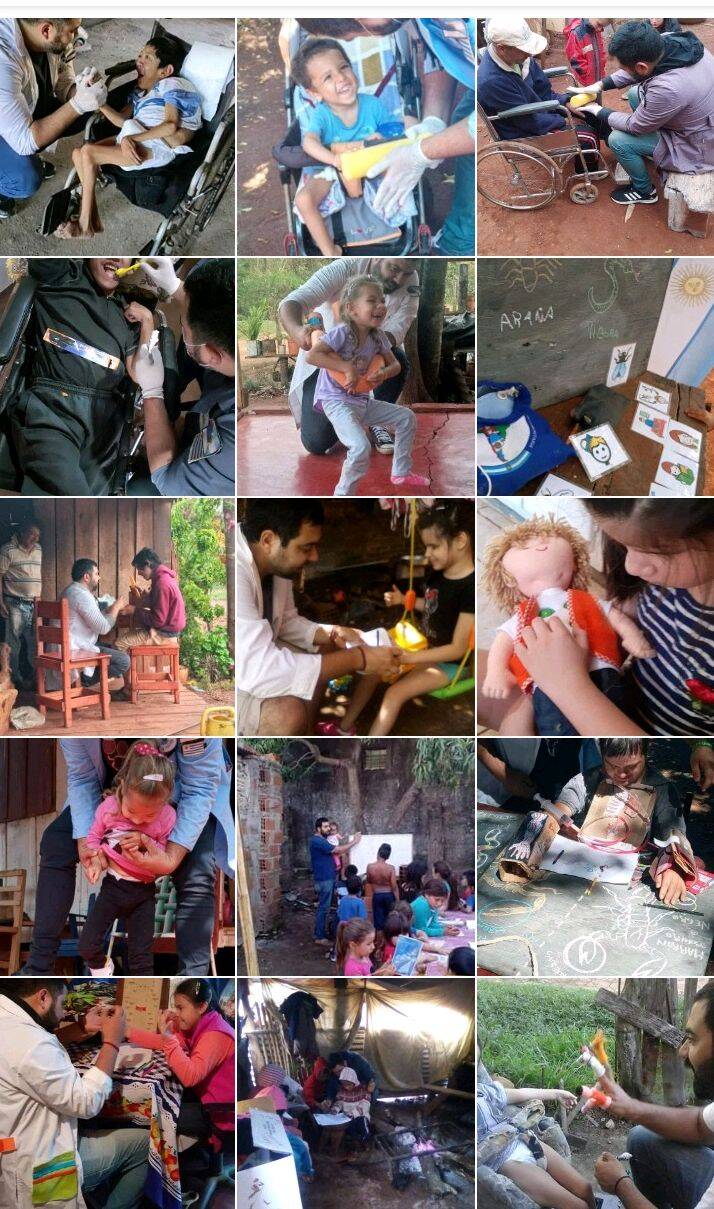


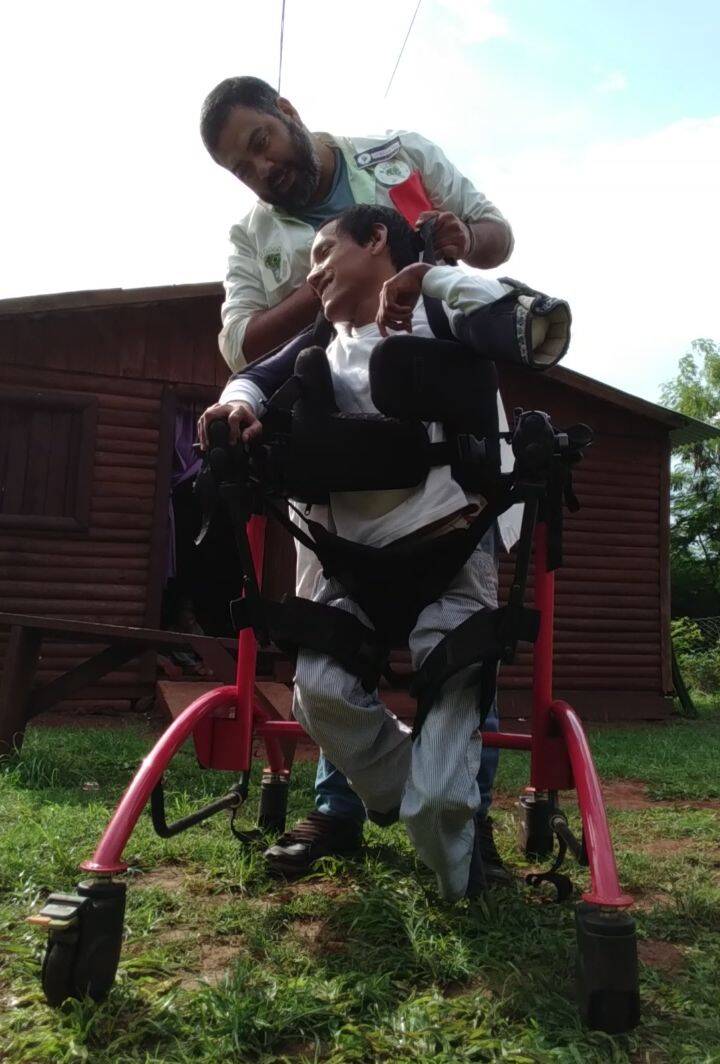
Our task/proposal is developed in Intercultural-Bilingual areas of the Border 🇦🇷🇧🇷🇵🇾 (Argentina, Brazil and Paraguay) and Tekoas Mby' a Guaraníes (Indigenous/Original).
The interventions imply activity in Guaraní, Spanish, Portuguese (and/or "Portuñol") and Sign Languages (Argentine Sign Language/LSA
It implies work with migrants (Brazilians and Paraguayans) and the coexistence of diversity of idiosyncrasies and cultural and social traits, added to the Educator who came from Uruguay 🇺🇾.
It presents an enclave between external and internal migrations (movements within the province of MISIONES 🇦🇷 due to seasonal/labor issues: tarefa (yerba 🌿), tobacco 🍂, cassava 🍠 and the timber industry .
It should be made clear that these are areas marked by Smuggling, Drug Trafficking, presence of Child Labor and incidence of Trafficking/Trafficking in Persons (Prostitution and Rural Work).
Low-cost and resourceful provision of therapeutical as well as pedagogical services to children in remote areas
Caminos de Tiza by Escuelita Ambulante, Argentina: Provides support in remote areas, focusing on early disorder detection and assistive devices. Reached 14 communities and 365 children in 2023, training 10,000 teachers from 2014 to 2023.
Caminos de Tiza, run by the Argentine NGO Escuelita Ambulante, delivers therapeutic and educational support to disabled individuals in isolated areas along the Argentina/Brazil/Paraguay border. This programme emphasizes early neurodevelopmental disorder detection and assistive device provision, focusing on underserved indigenous communities. Entirely funded by donations and in-kind support, Caminos de Tiza reached 14 communities and 365 children in 2023, and has trained some 10,000 teachers from 2014 to 2023.
Problems Targeted
In countries with extremely remote regions and for indigenous communities there is a lack of therapeutic, pedagogical, and educational services for children with disabilities.
Solution, Innovation and Impact
Escuelita Ambulante's Caminos de Tiza, utilizing a mobile bus, offers therapeutic and educational services to children and youth with disabilities in remote rural areas of the Argentina, Brazil, and Paraguay border region, focusing on indigenous communities. The programme integrates various educational methods, including rural, special, and intercultural bilingual education, in four languages: Guarani, Spanish, Portuguese, and sign language. Its curriculum covers literacy, hygiene, primary care, sexual health, orthopaedics, assistive technologies, and early intervention. Caminos de Tiza also trains parents, caregivers, and teachers in recognizing neurodevelopmental disorders and maintaining therapeutic orthopaedic equipment. The project emphasizes stress reduction, sensory saturation management, cognitive accessibility, and medical methods. It also addresses autonomy and primary health care aspects, such as the use of nasogastric tubes, catheters, and dental hygiene. Founded by two volunteers with disabilities, the programme educates families on handling disabilities, providing resources and materials for continuous therapeutic/pedagogical support. It reaches people through community references and social networks, covering indigenous communities, rural areas, and impoverished neighbourhoods in Argentina’s north-eastern region. Staffed by volunteers without external funding, Caminos de Tiza ensures service quality through public accountability, academic contributions, and community-based management.
Funding, Outlook and Transferability
Escuelita Ambulante Caminos de Tiza, founded by two individuals with disabilities, operates independently without significant funding or public sector support. The organization primarily leverages social networks to attract sponsors and benefactors, securing donations including food, therapeutic, orthopaedic, educational, and pharmacological supplies. Notably, Caminos de Tiza takes pride in its autonomy from government assistance. However, it has significantly influenced government policies regarding child care and education in remote areas, with aspects of its approach being adopted in public caretaking services.

On Disability:
Teaches uses (care and hygiene) of orthoses and prostheses, Early-Timely Stimulation, Psychomotor Skills, Sensory Integration, and develops in areas of Illiteracy and linguistic diversity such as Native Peoples, Border areas (we teach classes in four languages: Guaraní, Spanish, Portuguese and Sign Language), Ideo-visual material for understanding procedures or pharmacological consumption (dose, dosage, etc.).
It then provides a Pedagogical model (highly functional, for example during the COVID-19/Coronavirus Pandemics).
Records, videos, links, scientific, academic and didactic contributions, as well as impact on Public Policies can be seen at: www.facebook.com/caminosdetiza/ www.escuelitaambulantecaminosdetiza.webador.com)
We work on Signage (recognition of products by visual semiotics: corrosive, electrical, toxic, flammable, etc.) to avoid domestic accidents.
Semiology (to recognize symptoms and symptomatologies for early detection of health problems and specialized medical consultation).
It is based on a Therapeutic-Orthopedic-Pedagogical, Itinerant intervention, applicable in/to territory, which leaves Installed Capacity, allowing continuities and sequences of intervention by providing subjects and/or referents with strategies and resources (low/zero cost). in response to Sanitary/Health needs.
Designs low/zero cost materials and strategies (Artisan) for Psychomotor Skills, Early Stimulation - Timely and Psixoprophylaxis, which generates resource banks for professionals.
It allows an educational - preventive model adaptable to contexts such as refugees, displaced people, post-catastrophes, even in war conflict zones, in addition to providing a response (mainly in attention to Functional Diversity/Disability) in transhumant communities.
With this format, the Community School is transformed into a Primary Health Care Center from the Educational point of view, and its mobile dynamics allows the early detection of markers / indicators for specialized consultation (sexual abuse, domestic violence, malnutrition, Neurodevelopmental Disorders , etc.).
As Health Promoters, the achievements of reducing cases of Zoonoses and Parasites, Mortality and Child Malnutrition, eradicating teenage pregnancy, and the achievement of relevant psycho-motor achievements (documented) adding complementary processes - alternatives in Sign Language, Braille , Augmentative Alternative Communication (which allows the Inclusion of People with Disabilities). Our impact reaches the achievement of 100% of vaccinated children, the development of Public Policies such as the use of Pictograms in Hospitals or municipal ordinances of care in/for disability.
The Model has been highlighted by the United Nations and the Organization of Ibero-American States, for example, for its functional applicability.
We firmly believe that outside of scientific research, apparatus, experimental treatments or pharmacological development, fields at the central level of medical-clinical contributions, expand the conception of contributions to health to educational interventions, distinguishing a model of Therapeutic-Pedagogical intervention would generate a precedent and example, that more and new Institutions and Organizations would attend to this dimension of prevention and Primary Health Care, and Psychoprophylaxis.
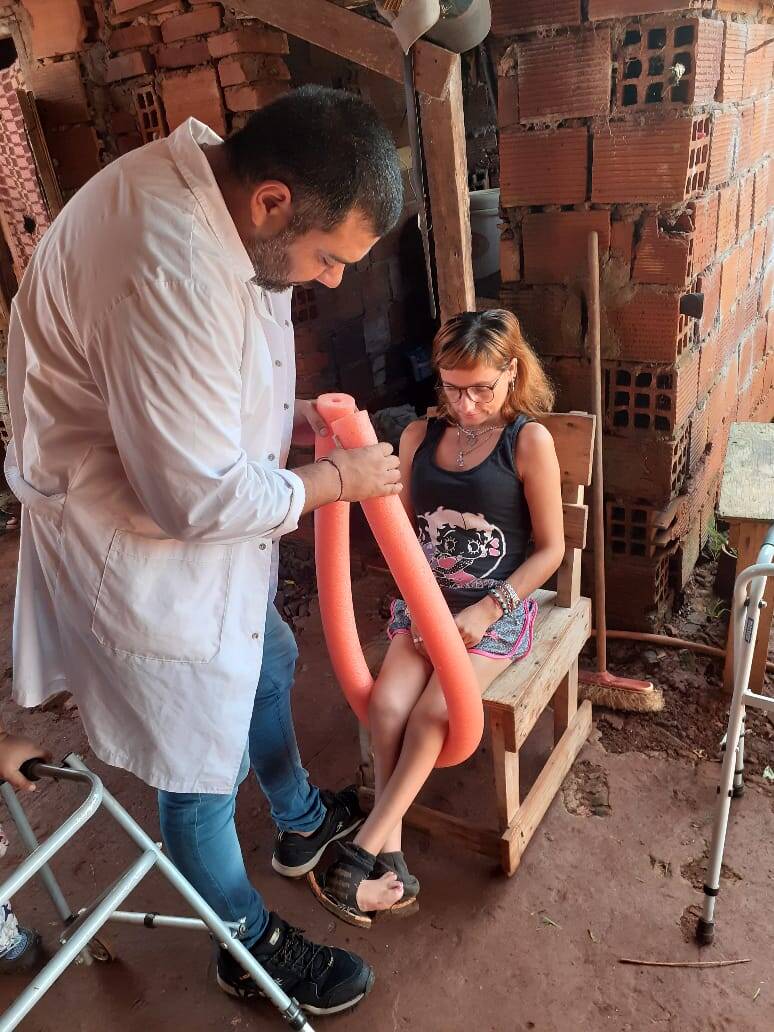
SUSTAINABLE DEVELOPMENT GOALS
The Sustainable Development Goals (SDG/UN) imply in their principles (also) addressing the social, educational and labor Inclusion of People with Disabilities and Native/Indigenous Peoples. From the Early Childhood and Community Education Spaces, the development and implementation of social and cultural projects that address: End of poverty: generating spaces for training and training for genuine work, especially literacy and the generation of Public Policies and Rights. Zero Hunger: generating Soup Kitchens and Community Kitchens, teaching crops and production (raising chickens/eggs, chickens, orchards, etc.). Health and Well-being: generating education in Primary Health Care (PHC), especially the prevention of diseases typical of the context (dengue fever, chikungunya, leishmaniasis, toxoplasmosis, leprosy, scabies). Work is also being done on water purification techniques and housing improvement. Vaccination, and early detection of: Autism, dyslexia, visual and/or hearing problems, specific language disorders, etc.
RESUME
"CAMINOS DE TIZA" (School)🇦🇷
https//:www.escuelitaambulantecaminosdetiza.webador.com
📧 caminosdetizaargentina@gmail.com
www.facebook.com/caminosdetiza/
It is an itinerant community school in garbage dump areas, indigenous villages, rural colonies, based on Emergency Pedagogy/Palliative and Special Education, which provides Didactic-Pedagogical interventions to children at risk of dropping out/repetition/exclusion from school, migrant communities, in intercultural bilingual contexts and drug trafficking, smuggling, Human Trafficking, illiteracy and Child Labor. It is an alternative / complementary school with situated teaching (strategic - situational) that addresses Disability (Special Education), Linguistic diversity (we teach in 4 languages) and community needs (educating on and from topics of need.
This modality, adaptable to contexts of refugees, displaced persons, remote areas, post-catastrophes (floods, earthquakes, pandemics), has an educational modality based on the Activities of Daily Life, and from them significant learning from which to carry out Scientific, Functional, methodological and social Literacy, in a School that covers Health Education (prevention of diseases, zoonoses, parasitosis, Hygiene issues), for risk reduction (prevention of domestic accidents, burns, electrocutions, poisoning, accidents with poisonous animals, fires); and in Disability educated in ways to attend to and understand Diversity / Diagnoses (teaching Rights, use of technological materials, Pictograms, Sign Language, uses of orthopedic and/or Therapeutic elements, etc.), while creating didactic-pedagogical knowledge (Didactic Designs of Cognitive Accessibility).
This is how Education is done from Comprehensive Sexual Education in children, to early detection of markers of Neurodevelopmental Disorders. An Educational modality that reduces school absenteeism, leaves Installed Capacity, and consolidates the (re)institutionalization of children to the Educational System (and with it access to vaccines, documents, public policies, etc.).
A school that not only guarantees the Right of children to go to school, but also requires school to go to children (especially those excluded). The only school that combines Special, Home - Hospital, Rural and Popular modality, and establishes practical ideas for Home Schooling modes.
A school that breaks with the traditional conception of school, and proposes an innovation to pedagogically serve groups/subjects with Discontinuous school trajectories. A modality that understands the teacher as a school in himself.
We therefore develop a format of Palliative Education/Emergency Pedagogy, educating/teaching Sciences (Natural, Physical and Social), as well as Language and Mathematics, by teaching them from exploration and experimentation, curiosity and wonder, in hybrid formats (artisanal and technological), but focused on addressing/understanding problems of/in their community; This way they learn to prevent accidents (or how to deal with them), with CPR, Heimlish Maneuver or Safety Position they learn about anatomy, physiology (Human Body), or become ideologically literate to understand the context (for example learning signs: prohibited, electrical, corrosive, toxic, etc.). The fundamental role of learning immersed in their context (they learn from the Activities of Daily Living and them), so the classrooms are their homes and patios, where they learn from responsible pet ownership to preventing accidents with poisonous animals (especially arachnids and snakes).
We are the only Latin American community school to address the educational needs of children with disabilities in rural and indigenous areas; in teaching everything from using an Anti-decubitus mattress to a nebulizer, to instructing on topics such as Postural hygiene or the use of technological elements (assistive technology). At the same time, it is highlighted that Didactic-Pedagogical and Therapeutic designs are generated from these tasks, as well as academic, scientific and technical knowledge (exhibitions and conferences, symposiums, congresses, etc.).
EDUCATION 👨🏾🏫🚸
Adults are educated/taught through work with their children, recreating popular knowledge and applied daily life activities and from there Scientific Literacy, Phenomenological awareness and school content.
It means starting from significant learning of application (useful, methodological - procedural learning) such as Hygiene topics (personal, dental, etc.), prevention of domestic accidents (fires, burns, poisoning, electrocutions, etc.), or incidents with poisonous animals (examples from which physics, chemistry, biology, etc. are learned). Also from experimentation, observation and exploration, useful things are taught to understand/care for their children (especially in cases of Disability), from which Rights, anatomy, physiology, physics, etc. are taught). That is, a modality of pedagogical intervention whose practical learning is transformed into learning of curricular contents (with and through their children).
This transforms each home into an Educational Community, where the adult, from his or her previous knowledge, learns the scientific reasons for his or her practices (why water boils, how clothes dry, how to preserve food, cold chains, reading labels, etc./examples), in addition to well-founded strategies on how to care for/understand their children.
This allows for flexible, context-adapted learning, Problem-Based Learning, and Evidence-Based Information, in a format that avoids absenteeism, leaves Capacity Installed, and reverses teaching from the practical to the theoretical.
With a target group of illiterate parents/adults, in nomadic communities (they migrate for labor seasons), in areas of poverty and exclusion, with low/no connectivity (rural, remote areas), and with an absence of spaces where they can continue Adult Education, this semi-School at Home mode allows for situated teaching, which responds to immediate needs, and which adapts the content to the environment (examples: to work on vaccines and the immune system, tetanus prevention is worked on in precarious/rustic houses; if the school content were physics, with water purification techniques, concepts such as phases, homogeneous/heterogeneous, decantation, states of matter, etc. are taught).
Improvement of hygiene habits (and their understanding) Reduction of zoonoses and parasites. Educational re-institutionalization Literacy Eradication of domestic accidents Installed capacity to understand/care for their children (with disabilities)
INNOVATION(S)
It is scalable and replicable; it is a functional adaptation to contexts of displaced people, refugees, nomadic communities, even post-catastrophes if the didactic sequences/pedagogical continuities are interrupted.
It is a model that addresses/understands the education of adults (and children) in remote, rural areas, or migrant societies (such as seasonal workers or muleteers), which poses an innovation in responses to alternative/complementary education where there are no physical schools (and where the Educator in his/her training can detect markers of sexual abuse, domestic violence, situations of confinement, etc.).
This alternative school arises to provide pedagogical assistance to out-of-school children (especially with Disabilities), in remote and/or vulnerable areas, in Indigenous Villages or Rural areas. It generates an educational community, where parents (usually functionally illiterate) are educated through their children, and where useful/practical/applicable knowledge is learned, which is useful for those who are going to continue higher education, as well as for those who remain in the communities in terms of their quality of life.
REFERENCES IMPACT
Reduction of Illiteracy. (Re)Institutionalization of 700 children into the Educational System Reduction of Zoonoses and Parasites Eradication of Child Labor accreditation and certification of knowledge. zero case of child pregnancy. zero cases of Infant Mortality Academic and Social Scholarships for Students. Integrate honor rolls in other schools. Zero cases of Human Trafficking in the Communities. Construction of Community Libraries Development of Satellite Classrooms in the Jungle (Indigenous Peoples) Restitution to Educational Inclusion processes.
https://escuelitaambulantecaminosdetiza.webador.com/aportes-academicos-pedagogicos in the link academic, pedagogical and scientific production published by Universities, cited by Ministries of Education or Institutions/Educational Organizations of different countries.
https://escuelitaambulantecaminosdetiza.webador.com/extras-documentos links to professional, training documents (courses, diplomas, moocs, qualifications, etc.) as a Community Educator
Crea tu propia página web con Webador